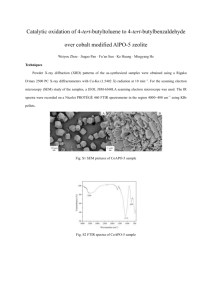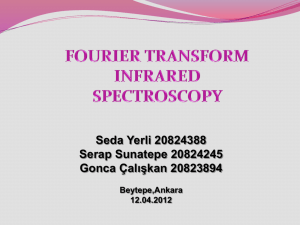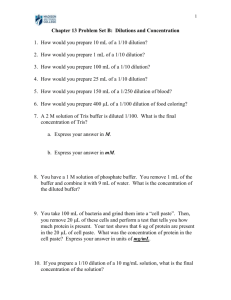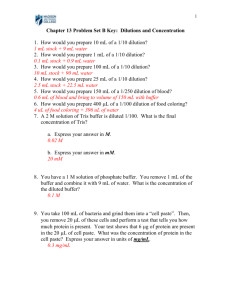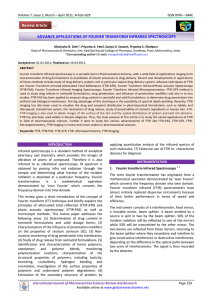Blood Analysis using ftir spectroscopy
advertisement
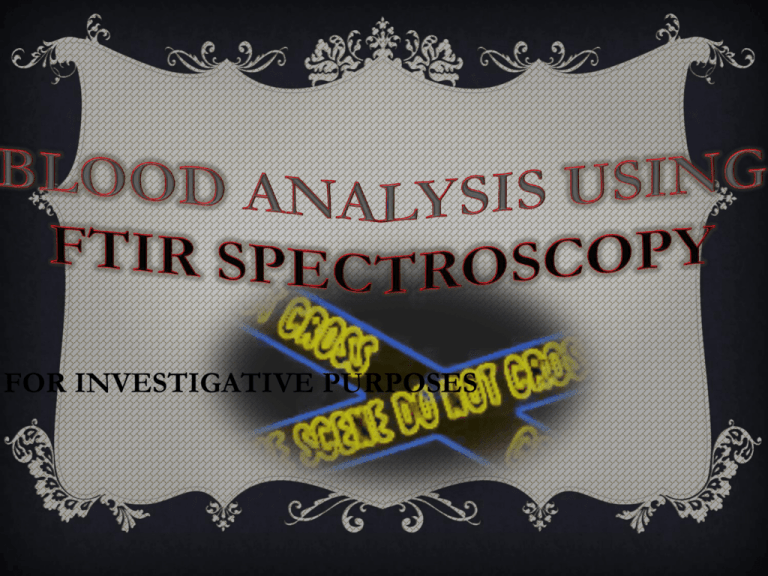
FOR INVESTIGATIVE PURPOSES INTRODUCTION WHAT IS THE FTIR? WHAT IS ITS PURPOSE? WHY USE THIS INSTRUMENT AS PER OTHERS? MORE INSIDE INFORMATION ON FTIR WHAT IS FTIR? PURPOSES? FOURIER TRANSFORM INFRARED SPECTROSCOPY MEASURES INFRA RED RADIATION BETWEEN THE RANGE 450cm-1 TO 4000cm-1 or (2,500 nm to 22,000 nm) H O W A T T E N UA T E D T O T A L R E F L E C T A N C E I R WORKS REASON FOR USING THIS INSTRUMENT Other techniques that were used in the past gave false negative and false positive results for the presence of blood This instrument is easier to use as per the salt plate FTIR OBJECTIVES Test for the presence of blood under certain conditions • • • • Burning blood Serial dilution of blood Denaturing by using bleach Aging over a period of time THE SPECTRA OF BLOOD -COOH -NH-C-H Stretch METHODS Aging Blood • • • • • • Prepare slides with blood drop on each. Date them Place a drop by itself on the spectrometer to analyze spectra on the first day Leave the other slides to dry When retesting it, wet a swab with distilled water and swab as much blood onto the swab Dab it onto the spectrometer and run the spectra RESULTS OF AGED BLOOD Plot of peak area 2600cm1 to 4000cm-1 versus log of time Plot of peak area 1200cm-1 to 1900cm-1 versus log of time 0 0 -22200 0 1 2 -22400 -22500 -22600 1 1.5 2 4 -1000 -1500 -2000 -2500 -3000 -22700 -22800 3 Peak Area Peak Area -22300 0.5 -500 -3500 Log of Time -4000 Log of Time 2.5 3 3.5 METHODS Serial Dilution • • • • • Obtain 10ml of blood Pipette 9ml from the 10ml and then add 1ml water After this dilution obtain another 9ml of the previous sample and add another 1ml of water Shake well after adding water to each sample Repeat process 4 times RESULTS OF SERIAL DILUTION 104 100 95 90 85 80 75 %T 70 65 60 55 50 45 40 35 31 4000 3500 3000 2500 2000 1500 cm-1 diluted diluted diluted diluted Name blood (0.1ml) blood (0.01ml) blood (0.001ml) blood (0.0001ml) Description Date Thursday, March 20 2014 Sample 054 By Administrator Date Thursday, March 20 2014 Date Thursday, March 20 2014 Date Thursday, March 20 2014 1000 450 RESULTS OF SERIAL DILUTION Plot of peak area ~3307cm-1 versus log of dilution factor 50.4 50.3 % TRANSMITTANCE 50.2 50.1 50 49.9 49.8 49.7 49.6 y = -0.287x + 50.575 R² = 0.9772 49.5 49.4 49.3 0 0.5 1 1.5 2 2.5 LOG OF DILUTION 3 3.5 4 4.5 METHODS Burning Blood • • • • • Get a watch glass and place a drop of blood on top Get a ring stand with clamp and set it up with the watch glass on top of the clamp Light a Bunsen burner and burn the sample until it turns completely black and unnoticeable as blood Wet a swab with water then swab the sample Use FTIR to test the sample RESULTS OF BURNING BLOOD 4000.00cm-1, 101 99.36%T 2595.67cm-1, 98.83%T 1940.96cm-1, 98.23%T 95 1324.96cm-1, 91.18%T 90 85 80 75 %T 70 1638.23cm-1, 72.02%T 65 60 55 50 3325.10cm-1, 51.19%T 45 40 35 31 4000 3500 3000 2500 2000 cm-1 Name burned blood drop Description Sample 062 By Administrator Date Thursday, March 27 2014 1500 1000 450 METHODS Bleaching Blood • • • • • Obtain a test tube and a bottle of bleach Place 0.5ml of blood into the test tube using a Pipette Fill the test tube half way with bleach Stir the solution in the test tube Pipette some of the sample from the tube and test it on the FTIR spectrometer RESULTS FOR BLEACHED BLOOD CONCLUSION The instrument is reliable in detecting the presence of blood under all four conditions, however it does not detect a simultaneous trend with aged blood Easier to move around REFERENCES Charlotte-Maria Orphanou BSc (Hons), D. H. (n.d.). A Preliminary Investigation into the use of FTIR Spectroscopy . Retrieved from Staffordshire University: http://www.staffs.ac.uk/assets/FSSocPoster_tcm44-55830.pdf Edita Botonjic-Sehic, C. W. (2009, February 1). Forensic Application of Near-Infrared Spectroscopy: Aging of Bloodstains. Retrieved from Advanstar: http://www.spectroscopyonline.com/spectroscopy/Near-IR+Spectroscopy/Forensic-Application-ofNear-Infrared-Spectroscopy/ArticleStandard/Article/detail/583780?contextCategoryId=36822 Sciences, P. L. (n.d.). FT-IR Spectroscopy: Attenuated Total Reflectance (ATR). Retrieved from Perkin Elmer : http://www.utsc.utoronto.ca/~traceslab/ATR_FTIR.pdf Serology: Blood and Other Bodily Fluids. (2013). Retrieved from Indigent Defense Services: http://www.ncids.com/forensic/serology/serology.shtml Stephen L. Morgan, P. M. (2011, July). Rapid Visualization of Biological Fluids at Crime. Retrieved from NCJRS: https://www.ncjrs.gov/pdffiles1/nij/grants/235286.pdf
